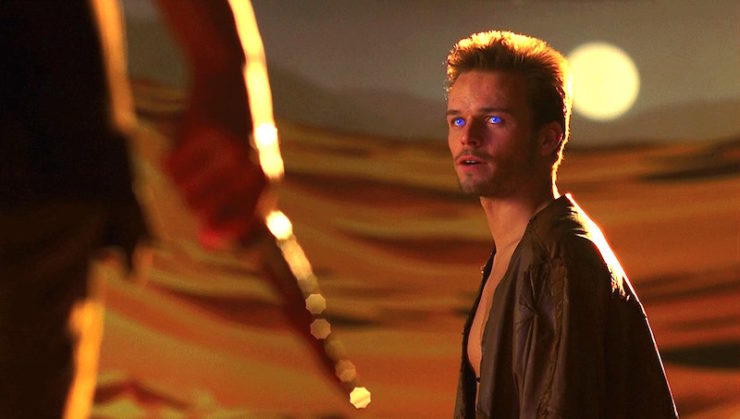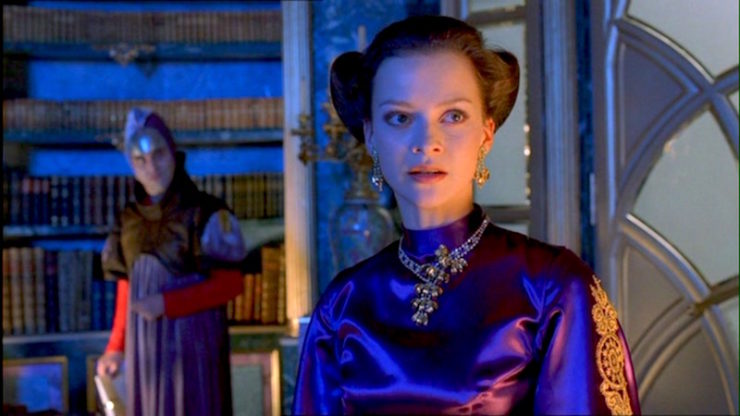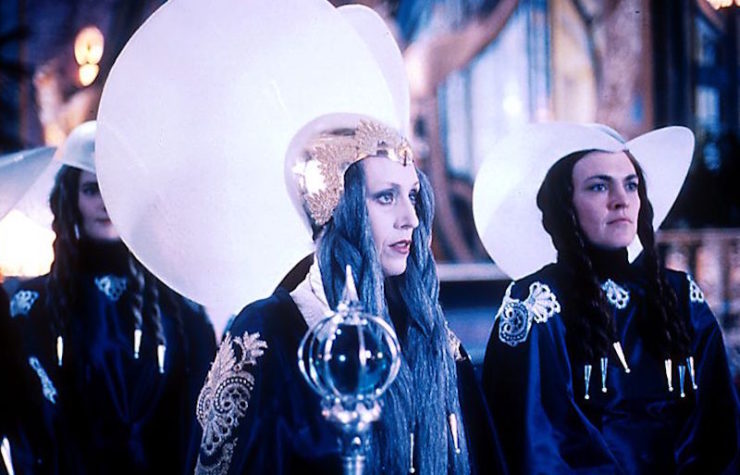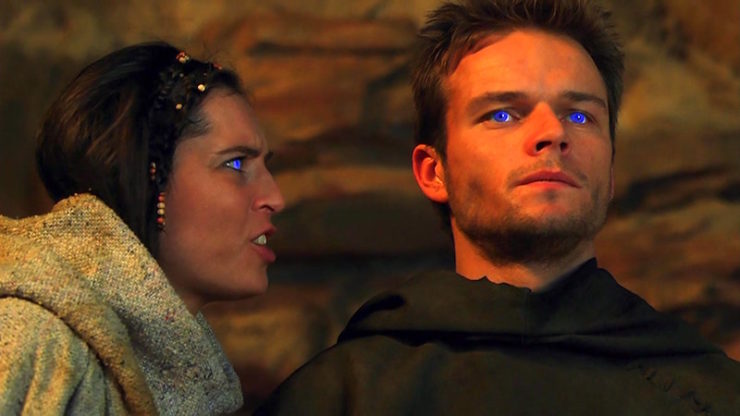Syfy (previously known as the Sci-Fi Channel) went through a minor renaissance in the late 90s and early aughts, producing television that set the bar for a lot of fascinating entertainment to come. Without shows like Farscape, Battlestar Galactica, and Stargate, it is doubtful that the current television milieu—where shows like Westworld and American Gods are considered high quality entertainment—would exist in the same form.
This was also the same era in which they developed two Dune miniseries. The first came in 2000.
Frank Herbert’s Dune was a massive production for a television project, with any estimated twenty million dollar budget for three film-length episodes that encompassed each “book” within the Dune novel. It featured an international cast and won Emmys for effects and cinematography. It was a massive undertaking for the channel, and to this day it remains (along with its sequel Children of Dune) among the highest three rated programs that Syfy has every produced.
The Dune miniseries is an excellent place to delineate the line between how close an adaptation of a book should run in order to make for a good viewing experience. This is a question that always needs considering when literature makes the turn to cinema, but the balance is rarely achieved. And while the Syfy miniseries is better than any other version on offer, it doesn’t reach spectacular heights due to the desire to be as close to the written text as possible.
Among the parts that sit strangely is the pacing of the whole thing; while the idea of giving each section of the book its own film-length treatment seems sound, the story naturally drags at certain points in the book that work in prose but not on screen. There are also places where it seem as though the narrative gets over-explained in an effort to be sure that no one watching is left behind. It’s a good instinct, but it can get tedious in places. There are lines that seem lifted from a careful checklist of What Must Be in A Dune Movie: “Oh good, we got that bit in. Now this bit.”

The cast is a fascinating array of performers, but some fulfill their parts better than others. Scottish actor Alec Newman was selected to play Paul Atreides, and he isn’t quite eerie enough when the occasion calls for it. He’s also too old to play the part, but that was a conscious decision of the part of the writer-director John Harrison—he was concerned that he wouldn’t be able to find the right talent if Paul were cast as a teenager. The problem with making that choice is that the script actually pens him as more teenager-like than the book ever did; Paul has plenty of moments were he is petulant and overly-stubborn and fails to discern the motives of others the way Paul does in the novel. Making that change would have been fine with a teenaged actor, but it’s odd coming from someone who is clearly 25 years old. He gains his footing more as the story goes on, but it’s a odd way to begin.
William Hurt is not the person that I’d normally consider for Duke Leto, but he brings a certain reserved calm that works for the character. Saskia Reeves, on the other hand, embodies everything that you would expect from Lady Jessica in both bearing and commanding presence. Barbara Kodetová is divine as Chani in both her sensitivity and fierceness, and Uwe Ochsenknecht makes a wonderfully gruff Stilgar. Somehow Matt Kessler (later of Middleman fame) is playing Feyd-Rautha, and it’s the strangest casting choice you’ve ever seen, but it’s also hard not to love the strangeness of it. Giancarlo Giannini was an excellent pick for Emperor Shaddam, and it’s always amazing to see him act through an array of increasingly improbable costumes.
But the real gold standard is born by Ian McNiece, who manages to make the Baron Harkonnen—easily one of the most despicable characters in science fiction literature—every bit as conniving and vicious as he needs to be… and every bit as fascinating. McNiece has a superb sense of how to make the baron mesmerizing to watch no matter how odiously he behaves; when so much of the narrative turns on paying attention to Harkonnen scheming, it is desperately important that their plotting holds our attention. Every time he ends his scenes on one of those goofy rhymes, you kind of want to punch the air and groan at the same time.

One of the only places where the miniseries deviates from the novel is arguably the smartest change it makes in the adaptation; the choice to make Irulan an active participant in the narrative, making her way through the machinations of the other houses to learn the truth about what is going on between her father, House Harkonnen, and House Atreides. It doesn’t always work (the point where she goes to see Feyd seems particularly silly, as it couldn’t be more obvious that she’s attempting to get information out of him), but when it does, it helps to keep the audience apace of what’s going on. Irulan’s position prevents a lot of unnecessary infodumping because she learns as she goes and informs the viewer as a result—preventing the need for a lot of ridiculous voiceover work (hi, David Lynch). Her appearance at the dinner party hosted by House Atreides in the first episode is such a smart reworking that I sometimes forget she doesn’t show up to the party in the novel. Julie Cox is elegant and cunning with the part, and makes Irulan’s own journey every bit as interesting as Paul’s on the flip side of the political machine.
The effects of this series read like a master class in making a relatively small (for the scale of the project) budget work like magic. While plenty of the special effects shots are clearly reused throughout, they are still well-rendered. The matte backdrop paintings used in the desert sequences are gorgeous, and while an occasional sound stage effect is discernible from not shooting the desert scenes outdoors, it is still an impressive feat. The Fremen blue-eye effect was achieved in a fascinating way—the actors were given UV contact lenses and then filmed with special cameras to catch the light. As a result, the glow of Fremen eyes is particularly riveting in this version. The soundtrack is also beautifully evocative of the the atmosphere, an impressive turn out by Graeme Revell.
But the real heroes of this miniseries are the people who did the design work. The costumes and sets are gorgeously appointed and so shrewdly thought through; the Bene Gesserit garb is utterly unique but still has a vague sense of “nun” about it, the complicated construction of Irulan’s hats and gowns are gravity-defying and glorious, activities shown in the sietches are varied and vibrant, the separation of various groups by color selection and fabrics and symbols is clear and concise. The fight choreography positively sparkles in all the places where it counts. Also, the stillsuits actually look like reasonable interpretations of what a stillsuit should look like, blending into the desert surroundings, built like functional everyday clothing. The people who were constructing this world clearly loved it, and it shows in every frame. For so much detail to come through in a television miniseries on a cable network is astounding, and it reads like a much grander project that was rolling in money.

There are thematic resonances that get lost in the version. Despite wanting to stick close to the book, it seems as though effectively communicating how dark Paul’s journey becomes is difficult for most writers and directors to stomach. (Paul doesn’t make it rain in this version, but he does make a Madhi statue into a waterfall, briefly, with no indication of where that ability suddenly comes from.) The indication that Paul’s victory will lead to endless war and suffering is never carefully communicated in this version, likely to prevent the audience from coming away with a poor opinion of their protagonist.
Knowing all that… I would argue that while this version of Dune is impressive to look at, its successor—the Children of Dune miniseries—outstrips it in the end. We will get to it soon, but for now, this miniseries is the best possible version of Dune that you can find on screen. And it’s a great tool for introducing friends (if they won’t read the book, of course) into the fold. It is hard not to love any adaptation that clearly has so much love for its source.
Emmet Asher-Perrin wishes people actually dressed the way they do in the miniseries… sometimes. You can bug her on Twitter and Tumblr, and read more of her work here and elsewhere.










